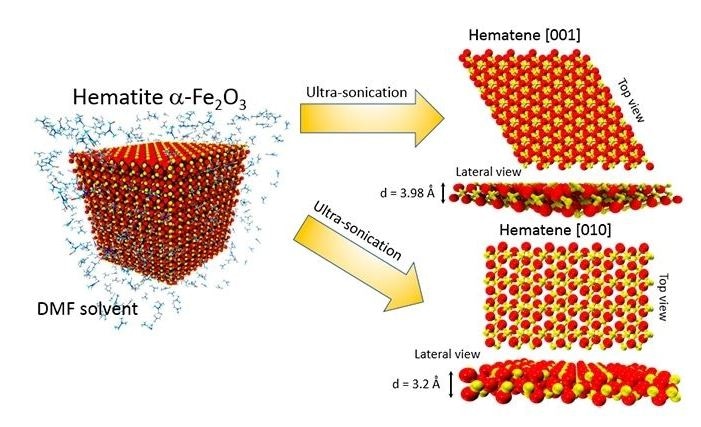Jul 30 2018
Since graphene was isolated in 2004, there has been a race to develop innovative two-dimensional (2D) materials, which are single-layer substances that have a thickness of between one atom and a few nanometers (one-billionth of 1 m).
 International group of researchers including Brazilian scientists obtain new material from iron ore with application as a photocatalyst. (Image credit: Agência FAPESP)
International group of researchers including Brazilian scientists obtain new material from iron ore with application as a photocatalyst. (Image credit: Agência FAPESP)
They have distinctive characteristics that are related to their reduced dimensionality and have a vital role in the advancement of nanoengineering and nanotechnology. An international team of scientists including Brazilian researchers affiliated with the University of Campinas (UNICAMP) has been successful in synthesizing an innovative material with these properties.
The team extracted a 2D material called hematene from ordinary iron ore such as that mined in various parts across the globe, including Brazil. Only three atoms thick, the material is considered to have improved photocatalytic properties.
The innovation has been detailed in an article published in the Nature Nanotechnology journal. The study was performed at the Center for Computational Engineering and Sciences (CCES), one of the Research, Innovation and Dissemination Centers (RIDCs) funded by FAPESP, as well as at the time of a research internship abroad that was also supported by FAPESP through a particular scholarship.
Douglas Soares Galvão, a researcher at CCES and one of the authors of the study, told Agência FAPESP about the discovery. “The material we synthesized can act as a photocatalyst to split water into hydrogen and oxygen, so that electricity can be generated from hydrogen, for example, as well as having several other potential applications,”
The new material was extracted from hematite, one of the most prevalent minerals on Earth and the major source of iron, which is the most inexpensive metal, used in various products and most importantly to manufacture steel.
In contrast to carbon and its 2D form graphene, hematite is a non-van der Waals material, that is, it is held together by 3D bonding networks instead of nonchemical and relatively weaker atomic van der Waals interactions that are non-covalent (not involving the sharing of one or more electron pairs by atoms participating in the bond).
Since hematite has large crystals that are highly oriented and is a naturally occurring mineral and a non-van der Waals material, the scientists consider that is a remarkable precursor for the exfoliation of innovative 2D materials.
Most of the 2D materials synthesized to date were derived from samples of van der Waals solids. Non-van der Waals 2D materials with highly ordered atomic layers and large grains are still rare.
Douglas Soares Galvão
Hematene was produced by performing liquid-phase exfoliation of the hematite ore in an organic solvent - N,N-dimethylformamide (DMF). The exfoliation and formation of hematene in single sheets with a thickness of just three iron and oxygen atoms (monolayer) and in randomly stacked sheets (bilayer) were confirmed through transmission electron microscopy.
Tests and mathematical calculations were carried out to analyze the magnetic characteristics of hematene. The results demonstrated that they were different from the magnetic characteristics of hematite.
In contrast to native hematite, which is antiferromagnetic, hematene is ferromagnetic, similar to a common magnet. In the case of antiferromagnets, the dipoles are antiparallel and aligned in opposite directions. In the case of ferromagnets, the dipoles are parallel and aligned in the same direction.
“In ferromagnets, the atoms’ magnetic moments point in the same direction. In antiferromagnets, the moments in adjacent atoms alternate,” explained Galvão.
Efficient Photocatalyst
The scientists also studied the photocatalytic properties of hematene—its potential to improve the speed of a chemical reaction upon being energized by light. The results demonstrated that photocatalysis using hematene is highly efficient compared to photocatalysis through hematite, whose photocatalytic properties are familiar but not sufficiently strong to be useful.
If a material has to be an efficient photocatalyst, it should absorb the visible part of sunlight, produce an electrical charge, and transfer it to the material’s surface to execute the desired reaction.
Although hematite absorbs sunlight from the ultraviolet to the yellow-orange region, the charge generated by it is very short-lived. Consequently, it dwindles before reaching the surface.
According to the researchers, photocatalysis using hematene is more efficient since photons produce both negative and positive charges within a few atoms of the surface. The researchers discovered that when the new material was paired with titanium dioxide nanotube arrays, which offer an easy pathway for electrons to escape from the hematene, they could allow more visible light to be absorbed.
“Hematene may be an efficient photocatalyst, especially for splitting water into hydrogen and oxygen, and could also serve as an ultrathin magnetic material for spintronic-based devices,” stated Galvão. Spintronics (or magnetoelectronics) is an innovative technology used to store, display, and process information based on variations induced by the spin of an electron, which is directly coupled to its magnetic moment.
The team has studied other non-van der Waals materials for their ability to be used for developing other 2D materials with exotic properties. “There are a number of other iron oxides and derivatives thereof that are candidates for originating new 2D materials,” stated Galvão.